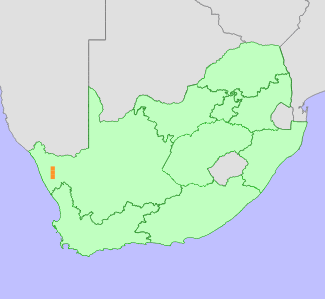|
Scientific Name | Conophytum roodiae N.E.Br. subsp. cylindratum (Schwantes) T.Smale |
Higher Classification | Dicotyledons |
Family | AIZOACEAE |
Synonyms | Conophytum cylindratum Schwantes, Conophytum cylindratum Schwantes var. primosii (Lavis) Rawé |
National Status |
Status and Criteria | Endangered A3cd |
Assessment Date | 2021/11/22 |
Assessor(s) | A.J. Young, P.G. Desmet, I. Ebrahim, D. Guo, A. Harrower, L. Jabar, L. Knoetze, C. Rodgerson, P.C.V. Van Wyk & N.N. Mhlongo |
Justification | This succulent is endemic to the Northern Cape province of South Africa with an extent of occurrence (EOO) of 641 km2 and area of occupancy (AOO) of 40 km2. The dwarf succulents that comprise this genus have been increasingly targeted by illegal collection in recent years and the vast majority of species are in high demand by collectors. Whilst there is no evidence of illegal collection at the time of this submission, closely related species, including some from the immediate area, have been illegally removed from habitat with a dramatic increase in the number of species and volume of plants targeted since 2019. This species is challenging to grow in cultivation and likely to be in high demand as a result. The threat of illegal collection is therefore regarded as very high for this particular species. The cryptic nature of these plants, often occurring between exfoliating slabs of granite, may serve to limit their removal from habitat. A decline of up to 75% of the population is however still highly likely within the next three generations (60 years) due to collection. Climate models also predict a decline of 52% of the suitable bioclimatic envelope by 2080 (generation length 20 years). This species therefore qualifies as Endangered under criterion A3. |
Distribution |
Endemism | South African endemic |
Provincial distribution | Northern Cape |
Range | This species is endemic to a small area of the Northern Cape province of South Africa. |
Habitat and Ecology |
Major system | Terrestrial |
Major habitats | Namaqualand Klipkoppe Shrubland |
Description | This species is restricted to the Namaqualand Hardeveld bioregion of the Succulent Karoo biome. The plants occur in grit-filled shallow pans or on gentle slopes or between exfoliating expanses of granite. This species has a generation length of 20 years. It is expected to be sensitive to the impacts of climate change as it does not disperse and while adapted to arid conditions, is dependent on limited seasonal rainfall. Species in the genus are sensitive to long periods of drought. Drought related mortality has been observed for other closely related taxa within the genus. |
Threats |
| This particular species is not currently threatened by illegal collection but it is likely that it will become a target in coming years as there has been a dramatic increase in the number of species and volume of plants of this genus targeted since 2019. Related species within the immediate area have experienced severe declines in population number due to illegal collection. Grazing and/or trampling by livestock is another localised threat to some subpopulations.
There is no decline in habitat quality for this taxon as inferred by changes in vegetation cover determined from changes in Enhanced Vegetation Index (EVI) between 1984 and 2018 using Landsat data (Venter et al. 2020). While it is not possible to model the response of this taxon to climate change due to its restricted distribution, the average loss to climate change for 15 more widely distributed Conophytum species occurring within the same region is used as an indication of likely impact to this species. Climate models for the likely emission scenarios where emissions stay at present day levels (RCP 2.6) (Hausfather and Peters 2020) and worst case scenarios where emissions continue to increase during the 21st century (RCP 8.5) indicate that there will be a loss of suitable bioclimatic envelope of between 72% and 99% by 2080 for Conophytum taxa within the region. However, as this species possesses certain traits likely to afford resilience to xerophytic conditions it is expected to have a level of resilience to climate change and the expected population loss is reduced by 20% to 52% based on the uncertainty of the response given the expected resilience of this taxon. Species in this genus have limited dispersal ability and migration to suitable habitats elsewhere is regarded as highly unlikely. |
Population |
It is often highly cryptic in habitat making accurate estimates of population size extremely difficult. It is also difficult to distinguish from closely related taxa in the genus. No formal estimation of the population size has been made but is thought to be no more than 5,000 mature individuals. The number of plants in this general area have been in decline in recent years due to an extended drought and the population is believed to be in decline.
|
Population trend | Decreasing |
Assessment History |
Taxon assessed |
Status and Criteria |
Citation/Red List version | | Conophytum roodiae N.E.Br. subsp. cylindratum (Schwantes) T.Smale | VU B1ab(v)+2ab(v) | 2020.1 | | Conophytum roodiae N.E.Br. subsp. cylindratum (Schwantes) T.Smale | Rare | 2017.1 | | Conophytum roodiae N.E.Br. subsp. cylindratum (Schwantes) T.Smale | Least Concern | Raimondo et al. (2009) | |
Bibliography |
Hammer, S. 2002. Dumpling and his wife: New view of the genus Conophytum. EAE Creative Colour, Norwich.
Hammer, S.A. 1993. The genus Conophytum: A conograph. Succulent Plant Publications, Pretoria.
Hausfather, Z. and Peters, G.P. 2020. Emissions - the 'business as usual' story is misleading. Nature 577(618-620).
Opel, M.R. 2004. The rediscovery of Crassula alcicornis. Haseltonia 10:38-40.
|
Citation |
| Young, A.J., Desmet, P.G., Ebrahim, I., Guo, D., Harrower, A., Jabar, L., Knoetze, L., Rodgerson, C., Van Wyk, P.C.V. & Mhlongo, N.N. 2021. Conophytum roodiae N.E.Br. subsp. cylindratum (Schwantes) T.Smale. National Assessment: Red List of South African Plants version 2024.1. Accessed on 2025/10/27 |
 Comment on this assessment
Comment on this assessment


